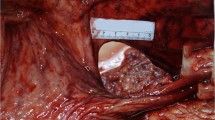Abstract
In death investigations, the volume of gastric contents may be useful concerning the time of death estimation, or to clarify the circumstances of death. Here, the case of a 4-month-old male infant who was found dead in his mother’s bed is presented. SIDS was assumed as the cause of death after initial police investigations. Later, autopsy results revealed that this case was a homicide due to extensive abusive head trauma. The infant had three skull fractures on the back of his head with subdural hemorrhage and cerebral oedema. The survival time after feeding him formula and corresponding the time of death was determined to evaluate the mother’s initial claims that the infant was alive several hours after feeding. In this case, the volume of stomach contents of the last meal was known. From the volume of milky fluid found in the stomach at autopsy, it was possible to estimate the time of death within a narrow time frame of less than one hour after feeding. The mother’s claims could be ruled out, and she later confessed to having killed the child soon after feeding him. Even methods with low precision for estimating time of death, like examining stomach contents, can be essential for solving practical cases. To our knowledge, this is one of the first published cases in which an infant’s stomach content was used successfully in the reconstruction of a homicide.




Similar content being viewed by others
References
Baur C, Spann KW, Tröger HD, Schuller E. Magenfüllung und Todeszeitpunkt. Beitr Gerichtl Med. 1980;38:193–7.
Berg S. Beweiswert der Todeszeitbestimmung (Überlebenszeit). Beitr Gerichtl Med. 1969;25:61–5.
Henßge C, Madea B. Magen- Darminalt. In: Henßge C, Madea B, editors. Methoden zur Bestimmung der Todeszeit an Leichen. Max Schmidt-Römhild: Lübeck; 1988. p. 221–4.
Holczabek W. Zur Untersuchung des Magen-Darmtraktes für die Todeszeitbestimmung. Beitr Gerichtl Med. 1961;21:23–32.
Horowitz M, Pounder DJ. Gastric emptying: forensic implications of current concepts. Med Sci Law. 1985;25:201–14.
Knight B. The use of gastric contents in estimating time since death. In: Henssge C, Knight B, Krompecher T, Madea B, Nokes L, editors. Estimation of the Time Since Death in the Early Postmortem Period. 2nd ed. London: Edward Arnold; 2002. p. 209–15.
Legge C. The use of gastric contents in estimating time since death. London, Queen Mary University of London, Master of Science in Forensic Medical Sciences thesis. 2011.
Legge CM, Payne-James J, Puntis J, Short S. Postmortem gastric content analysis: its role in determining time since death. In: Gall JAM, Payne-James JJ, editors. Current Practice in Forensic Medicine. Wiley & Sons Ltd.; 2016. p. 47–66.
Madea B. Methods of determining time of death. Forensic Sci Med Pathol. 2016;12:451–85.
Madea B, Knight B. Stomach content and time since death. In: Madea B (ed.) Estimation of the Time since death. 3rd ed. CRC Press, Boca Raton. 2016, 2023;213–22, 4th edition in print.
Madea B, Doberentz E. Child abuse. In: Madea B (ed.) Handbook of Forensic Medicine. Vol. 2. Wiley & Sons, Chichester. 2022;970–86.
Minns R. Non accidental head injury in children. In: Madea B (ed.) Handbook of Forensic medicine. 2nd ed. Vol. 2. Wiley & Sons, Chichester. 2022;939–69.
Tröger HD, Baur C, Spann KW. Mageninhalt und Todeszeitbestimmung. Methodik und gerichtsmedizinische Bedeutung. 1987. Max Schmidt-Römhild, Lübeck.
Bajanowski T, Vennemann M, Bohnert M, Rauch E, Brinkmann B, Mitchell EA, GeSID Group. Unnatural causes of sudden unexpected deaths initially thought to be sudden infant death syndrome. Int J Legal Med. 2005;119:213–6.
Author information
Authors and Affiliations
Corresponding author
Ethics declarations
Ethics approval
This article does not contain any studies with human participants or animals.
Consent to participate
Not applicable. The manuscript does not contain any identifying details.
Competing interests
The authors declare no competing interests.
Additional information
Publisher's Note
Springer Nature remains neutral with regard to jurisdictional claims in published maps and institutional affiliations.
Rights and permissions
Springer Nature or its licensor (e.g. a society or other partner) holds exclusive rights to this article under a publishing agreement with the author(s) or other rightsholder(s); author self-archiving of the accepted manuscript version of this article is solely governed by the terms of such publishing agreement and applicable law.
About this article
Cite this article
Doberentz, E., Wegner, A. & Madea, B. Value of stomach content in a case of fatal child homicide. Forensic Sci Med Pathol (2023). https://doi.org/10.1007/s12024-023-00705-3
Accepted:
Published:
DOI: https://doi.org/10.1007/s12024-023-00705-3




